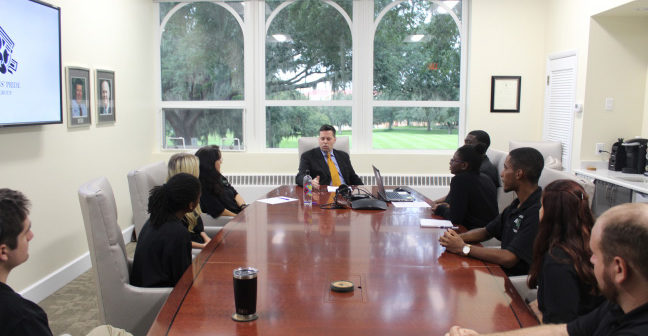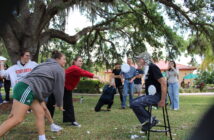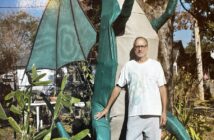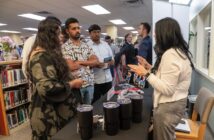When Dr. Jeffrey Senese talked about transitioning from provost to president, he talked about the past and everything he discovered about Saint Leo last year. When Dr. Senese talked about his plans as Saint Leo’s tenth president, he talked about the future and its possibilities. Everything is about growth and movement. From new buildings to increasing the students’ numbers and retention; it’s about building a bigger and better Saint Leo University.
“Look at any major university in the country. Look at USF; look at UCF, UT. They are all doing something. They aren’t staying in place,” he said. “We sat in place for three years… We’ve got to start moving and developing because it’s in our long-term interest; it’s in your [the students’]long-term interest.”
To explain this, he related it to his former university, Penn State, and how the value of his degree has increased due to improvements since he graduated.
“I graduated Penn State in 1982. The value of the degree today is 10 times what it was then because what Penn State did was continue to develop. They didn’t have a law school, didn’t have a medical school, didn’t have an IT school, didn’t have a business school at the scale they did. But they, over the 30 years since I left, they developed,” said Senese. “You [the students]should expect the same because your degree will increase value because there is more value now to attend.”
Senese plans to double the number of students on campus and do this within three to five year. Also, there is a push for an increase in international students on campus, and this will be done with the help of Dr. Senthil Kumar, vice president for University Campus Admissions and Center for Global Engagement. Senese worked with Kumar before at another university, where they were able to increase enrollment significantly.
“I worked with Dr. Kumar at a previous institution, and he and I moved an institution from 120/130 international students every fall to almost 600 every fall,” said Senese.
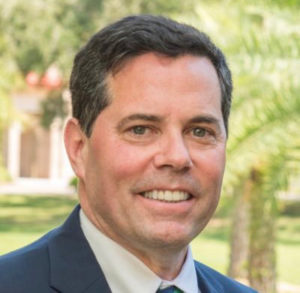
Senese hopes to address students’ questions and concerns through a suggestion box. Credit: Saint Leo University
Instead of simply attracting students from the Caribbean and Latin America, Senese plans to attract students from Asian countries, such as India, China and Malaysia. In fact, Kumar, along with another staff member, is currently in India recruiting and will move onto other Asian countries, such as China and Malaysia, within the next months. This recruitment trip is expected to increase the number of international students and to diversify the student body.
“We’re [at]about 450 international students; our goal is to double that,” said Senese. “The reason to do it is because it adds to the culture; it makes the experience better because if you’re in a business field or a communications field, you’re going to deal with people from all over the world.”
It is not only the international student population that he would like to double, but he also wants to double the entire campus student population. Thus, the plan over the next three to five years is to have 5,000 students on University Campus, and 1,500 of those students are expected to be international students. To push toward that goal, with Kumar’s recruitment efforts, Senese is looking to bring in 110 additional international students in Fall 2019 for a total enrollment goal of 1001 students on the University Campus.
Many students and faculty may wonder how Saint Leo would be able to accommodate the influx of students next academic year. However, Senese assures that there is space. Currently, 150 beds are available this year, so the University would be able to accommodate the additional 110 students.
Also, to accommodate the increased number of students over the next three to five years, Senese discussed new residence halls.
“The plan on the resident halls has been in place for a long time in terms of [leaning]towards more of the contemporary residence halls like we have in the apartments 5 and 6. We need to start moving on that,” said Senese.
These buildings are expected to either occupy West Campus, which Senese refers to as a green field, or replace one of the existing older residence halls on Main Campus.
“We haven’t made any of those determinations. We kind of like the 5 or 6 model. We like the apartment model, so we’re going to play with that,” said Senese. “We will have students involved in those kinds of planning committees too, so we won’t make those kinds of decisions all by ourselves.”
Either way, Senese is looking toward the development of West Campus. The University is looking at a piece of land across the street from Benedictine Hall that recently went on sale. He said the reason they’re looking at it is because of the expansion. The University cannot continue to “shoehorn” more buildings on Main Campus.
“I’m not going to put a parking lot on the green space,” Senese said as he pointed to the Bowl. “We need green spaces.”
Senese has visions of various facilities being built in the near future, such as a wellness center, an arena and a parking garage over by the Benedictine parking lot, while still maintaining the green space by the lake. Nevertheless, these plans are not officially on a master plan, but a master plan is in the works.
“The University currently does not have a master plan, which is very atypical for an institution of this size and character, so I’ve asked senior staff to begin to work with a firm to design a master plan,” said Senese. “And what master plans typically are is a sequence of ‘here’s what you’re going to do in the next three years, five years, ten years.’ And it maps out at the building level, at the parking level, at the academic space level what you need to do at each of those benchmark times. So within this I’m hoping that sometime in the academic year by the April board meeting that I can get board approval for a master plan that we can talk with you about, we can show you the image and show you ‘here’s what our ideas are with respect to that.’”

John Hall, the Editor-in-chief of The Lions’ Pride Media Group, conducted the interview with Senese. Credit: Christian Silva
One of Senese’s first plans of attack regarding the building of facilities on campus is the Wellness Center, which he plans for the groundbreaking to be this year. He hopes for the start of construction to be this calendar year, but he admits that the realistic time frame is this academic year.
He has a team around him to ensure that the plans run smoothly but also to get input from numerous people, including members from the student body, such as the SGU President Derick McIntosh.
“I am a big fan of consultation and collaboration. I don’t think the president should make all of those decisions by himself. So, I talk with people before I make decisions; I have no problem making a decision, but I want to hear what people think,” mentioned Senese.
He also gathered ideas for the Wellness Center by looking at least 20 other wellness centers, having visited a few. He has put together a list and given it to the architect to design the center. On Senese’s list are a lazy river, a recreational pool, a health bar and an indoor-outdoor feel with a great view of the lake. There is a possibility for a skate park to be an outdoor recreational space for the wellness center; however, Senese initially thought of having an ice-skating rink but came to the conclusion that it was too expensive.
He plans for the Wellness Center to be on West Campus on the highest part of the hill, where it is facing the lake. Along with the expansion of West Campus, he talks about implementing an automotive transportation that can run between West Campus and Main Campus. This would help students get between the two parts of campus.
As mentioned before, new residence halls are in the plans but after residence halls and after the Wellness Center would be Lewis Hall. Senese mentions that even though the building was made as contemporary as possible, other universities are surpassing us in the realm of science facilities. Therefore, the university is looking to update the building to ensure that it is contemporary.
“There’s just so much you can do with a building like that. We’re at a time where we’re getting passed by other institutions, so that has to be done. That’ll be an expensive building, so that’s going take a couple years to get our fundraising,” said Senese.
The updated Lewis Hall should house the current science programs, but Senese also talked about ensuring that there are clinical labs and other kinds of necessary facilities for health science programs, which are anticipated in the future. Due to the high cost of science facilities, Senese emphasized the desire for a new science facility to accommodate both the current programs in science and the future health science programs.
The science facility, the residence halls and a wellness center are expected to start being built within a couple of years. However, Senese also mentioned other facilities that should be built or updated down the road, such as a performing arts center, an admissions building, a library and even an arena.
For the arena, the plan is to put it across the street and this is the main reason for looking at purchasing the land there. Senese already has a conception for the design of the building.
“Here is my vision right now: it’s 15 feet off of the ground and the other side facing that little valley that is like 50 feet off the ground and it’s all glass looking into the valley; so, when you look at it from campus, you don’t see this big behemoth of a building,” said Senese.
He plans to maintain grass by having cross-hatching in the parking lot so that there are strips of grass in-between the concrete, ensuring that there is green. He further described the aesthetics and functionality of the arena.
“I’m talking about a regular arena that could be as large as 10,000 seats. So, it will be designed in a way (and there is model that I’m looking at for this) where the bottom bowl will be about 5,000; then, the other bowls (second bowl and third bowl) will house the rest,” said Senese. “You can close them off and there could be events going on in the arena while you’re using the main floor. So, it will be this multi-purpose thing.”
He is thinking of modeling the arena after The Ford Center in Evansville, Indiana in terms of the design and the multipurpose function. One of the functions for the arena is to be used by the nearby schools in Pasco County.
“So, the nearest arena to here is at USF. There are 18 high schools in this county that send their kids down there to graduate. There’s a big desire for them to graduate within Pasco County. What we need is a proper arena,” said Senese.
This arena would also be similar to the arena in Evansville, Indiana not just in its multipurpose nature but also because in its profit potential.
“The Ford Center arena makes four million dollars a year. So, it is a revenue producer; so, it will allow me to do other things for students here. Again, I’m thinking about students,” said Senese.
Senese plans to reinvest the profit gained from the operation of the arena into scholarships and jobs, especially for international students who are unable to get jobs off-campus.
Nevertheless, the construction of the arena would take three to four years because of the nature of this big project.
The other project is renovating the current library. He complements the library but also mentioned how it can be transformed into a more contemporary structure.
“The setting is lovely. I think it’s in a good place [but]it feels a little confined and old school to me. So, most libraries today are technology information hubs as opposed to stacks,” said Senese. “This one feels more like the stack model than the information hub model.”
The plan is to transform the “stack model” into a model that embodies an information hub. The vision is to have few books on the first floor and have mostly full-text databases. The top floor can then have books and can hold the quiet study areas. The plan is to ensure that there is digital access to books and the library can hold those types of databases.
“I think we need to contemporize it a little bit. I think if we bring…when we bring on health sciences their libraries don’t require physical collections; they’re all digital so that’s a different kind of collection development; so, it’ll have to evolve with our size,” said Senese.
The digital access to books and other forms of information would be beneficial for not only students on campus but also the student population at the Centers as well.
“I’m not going to only grow here; I want us to look at other Center locations. The more I expand out there, the more I’m going to need collection access digitally,” said Senese.
Senese is determined to not only focus on the development of University Campus but also pay attention to the Centers. Senese plans to attend the routine meetings that Dr. Melanie Storms, director of WorldWide holds with the other Center Directors to ensure that he knows what is going on regarding the Centers. He also wants a student advisory council, ensuring that he isn’t only focusing on University Campus but also paying attention to the Centers since the student population at the Centers make up more than 80 percent of the total University population.
Senese also remains committed to visiting the Centers. Last spring, he mentioned that he committed to going to every single Center between January 2018 and January 2019. When he started in January, within a couple of months, he visited several Centers, including Jacksonville Center, Savannah Center and five out of the seven Centers in Virginia. Now, he has visited more Centers, such as Corpus Christi and Key West, and he is about a third of the way through all, inching closer to his goal.
Senese also wants to develop University Campus more to ensure that there is less money being taken from the revenues from the Centers and injected in the Campus.
“What Dr. Kirk did to create this campus was build out there, so you use the revenue surplus to build the campus. I want to follow that same model, but I also want University Campus to grow so there’s a little bit better balance,” said Senese.
Therefore, he plans for both University Campus and the Centers to be developing to help with balance, ensuring that when University Campus gets big enough, it can for the most part fund itself and not have to rely on revenues from Centers when drops in campus’ enrollment occur, for example. Also, the balance in the development would also ensure that there is quality in academics, in particular, across WorldWide.
“Some of the programs out there they have refined. Others they have one person; that’s not enough. I don’t want the quality here to be affected by the quality out there. We can’t do a fantastic job here and not pay attention to out there. There’s got to be some balance,” said Senese referring to the programs at the CenterS.
The plans of developing the Centers also include building structures to house some of the Centers’ locations, instead of only leasing physical facilities, which the University is currently doing.
Along with enhancements to the facilities on University Campus and the Centers, the plans also include the enhancement of academic programs for both undergraduate and graduate programs. He has hopes to offer more programs, such as healthcare and engineering, but also offer programs that enable students to do their bachelors and masters in a set program. Senese mentioned possibly having more Business 4+1 programs, which involves students undergoing an undergraduate degree in business and immediately taking an MBA, or possibly having a 4+2, which involves similar structure program for health sciences and engineering. According to Senese, these programs would help the effort to invite undergraduate students to stay with the university for their master’s degrees.
Therefore, these changes, including advancement in programs, impact retention. There have been many conversations around the area of retention; Senese believes that one of the main problems with retention is lack of engagement.
“There’s about 40 years of literature research on retention and what the literature says, what works to increase retention and reduce attrition, is faculty and student contact, staff and student contact and student and student contact; so, in essence, engagement. So, we need to look for ways to help students become more engaged so whether adult students online or on-campus students,” said Senese.
Therefore, Senese is planning to increase engagement through various methods including the potential hiring of more student success coaches to ensure students have access to an advocate of some sort and the strengthening of faculty-student relationship in each class. One of the methods of increasing the faculty-student relationship is through “student success collaborative,” which is technology software that Senese used at one of his previous universities. This software would be used for faculty members to send messages to students through text regarding class absence and reminders, for example. This would enable faculty members to engage with students on a more personal level.
“We’re looking for solutions like that, that are university-wide. So, it will solve the problem of being able to engage people. It won’t solve the engagement problem, but it’ll allow us in our far-flung seven states to be able to get moving on that,” said Senese.
The other software that would be useful to increase engagement, especially for Centers, would be Adastra, and the university is in the process of implementing this software.
“It’s a scheduling software that’s fairly typical in higher ed that it will allow us to schedule across the entire university from here. So all the needs that the seven locations in Virginia have will be scheduled in a coordinated, unified way.”
This software will help with scheduling based on degree audits. Senese described the software and the benefits to retention.
“It draws off your degree audits; so, if this group needs English 234, it knows that there’s enough students for a class and it will put that on the schedule,” said Senese. “So, it draws off your actual student experience from the degree audit and then makes the schedule that way. Now, [what’s it’s done now,] it’s done pretty manually; we based it on history rather than what your actual needs are.”
This software seems to help with operational efficiency, resource allocation and acceleration of student completion, which can address student’s frustration with class being unavailable, and in turn, help with retention.

A part of Dr. Senese’s plan on integrating more in the Saint Leo community, involves taking pictures of anything out of the ordinary that he may see. These things have included Skateboarding monks and his weekly funny socks. Credit: Christian Silva
Also, there seem to be more unwelcomed changes, and it relates to the bookstore. This semester, the bookstore opted out of the having readily available textbooks in-store in favor of online purchase and an in-store pickup model, Senese assures decisions are made with the student’s interest in mind. He mentioned that this decision was made with the idea to ease the shopping without having buyers to search for books on the shelves and reduce costs, especially since Follett should match the prices to get the best deal. He related this to his son, a sophomore biology major in college, who spent $1,800 on books for the semester.
“So us having the purchasing power that we do across our university is supposed to result in savings that we pass on to you. We’re not trying to make money on the books, we’re trying to pass on the savings because the number, the expense, on that is crazy,” said Senese.
He is also mindful of the staff as well. When asked how he would handle staff employment and the recurring anxiety of staff layoffs, Senese said that laying off staffers is the last thing that he would want to do. He reflected on having to lay off individuals at a previous institution he worked at and the impact it had on the university as a whole.
“I was at a university where I had to do it three times, I had to lay off staff three times…it’s the most painful thing to do in the world. And it hurts the institution,” said Senese. “It hurts the institution longer term because they’re part of the culture. They’re part of the professional fabric of the institution; so, I’m going to do everything I can to not have that happen. But I can’t guarantee it, unfortunately; I’d love to be able to do that.”
Although he cannot guarantee job security for staff, he assures that when the University is on a path of growth that there is no need for layoffs.
“I plotted out what our enrollment has been over the years. We’ve had three downturns in our enrollment over the last 15 years or so. And after each of those downturns we took off, so after the last one we spiked 29 percent,” said Senese. “So, I’m going to believe in my heart that we’re at that point where we’ve gone through a little dip and we’re back on this kind of curve. So as long as we grow and as long as we achieve our financial goals I – that’ll be the last thing I want to do.”
Also, Senese is planning to be in contact with the student body, hearing their concerns and answering questions as much as possible. In an effort to cater to the students, he will try to fulfill the wants of students, and if the request or solution is not feasible, he will give a reason why it’s not. In fact, Senese also has a suggestion box, which can be located in an effort to understand issues or concerns that students may be facing. Also, last year, Senese had drop-in sessions, and he was able to meet with at least students on campus over the short time frame that he held those sessions. He plans to continue those this year and will get direction from SGU as well.
“So, it [drop-in session] was valuable enough that I kind of got a good sense for what students were thinking. And I’m going to depend on SGU for that as well to tell me what I should be and how I should be looking at things,” said Senese.
Check out the entire interview on video by visiting the Lions’ Pride Youtube page! https://www.youtube.com/watch?v=txcHt-MQ0fs

